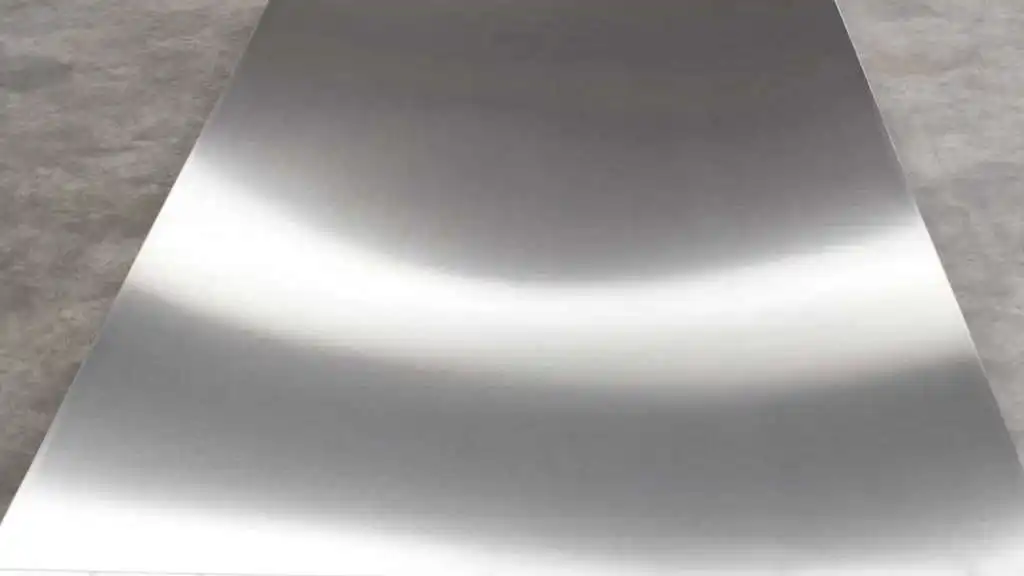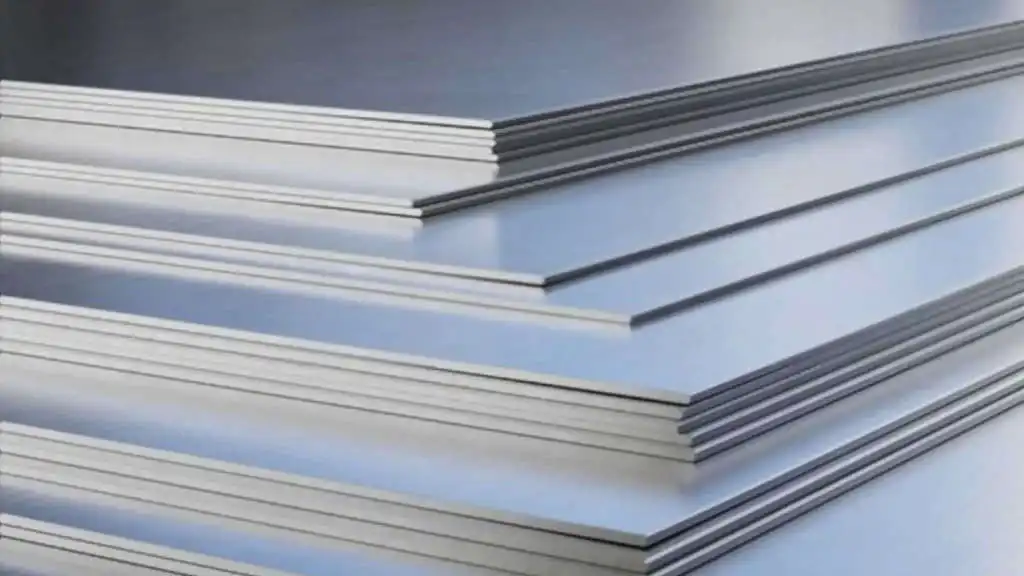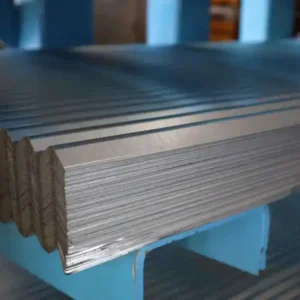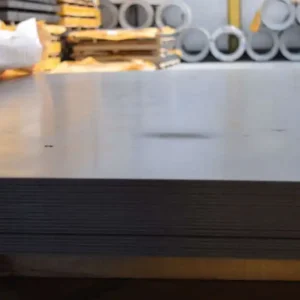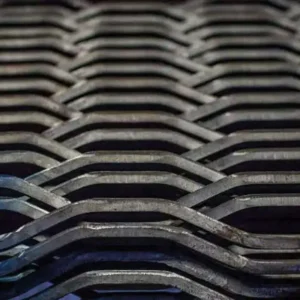Aluminum Sheet
Aluminum sheet is called the products obtained from Aluminum using the rolling technique. The name of the sheets, which is one of the most important products of the metal sector, is different according to the thin and thick. In this context, thin sheets are called sheets, while thick sheets are called plates. Aluminum sheets are as resistant as possible to atmospheric corrosion. With the help of these features, it is as simple as possible to take shape.
The electrical and heat factor arising from the basic property of aluminum is similarly seen in the sheets. It can be said that these sheets, which are very talented in terms of functionality, are also of high quality visually. For this reason, Aluminum sheets are used in different areas in decorative coatings. Although it is the most suitable for welding, it is a product with low mechanical properties.
Using aluminum plates in wrong areas causes wear of machine parts. It is necessary to decide on the Ideal Aluminium alloy according to the conditions it will be exposed to while purchasing aluminum plate or plate.
Aluminum is a light, silvery, corrosion-resistant metal with excellent machinability properties—the most common (most well-known) element after oxygen and silicon.
Aluminum is found in nature only as a compound. The basic material for the production of this metal is bauxite (Aluminium stone), which is a product that is formed as a result of weathering of limestone and silicate rocks and contains high (often over 50%) A12O3 (Aluminum bauxite).
Pure Aluminum is a material with low durability. Significantly high strength qualities—with relatively high tensile strength (stretchability) and flexibility limits—can be achieved by adding reasonable alloy components. Aluminum alloy materials are classified as “naturally hard” and “heat-treatable” materials.
But first, the question of “why Aluminium” should be addressed. Alternative products, especially a number of steels such as P-20, H13 tool steel and stainless steel, as well as copper-based alloys, often containing beryllium, are used in part (tool) and mold programs. They provide high durability and resistance to wear, and thermal conductivity in the case of copper alloys. But no material has all the properties desired for a particular application; Alternative materials are no exception, as they are heavy, often less machinable (machined) and have poor thermal conductivity, for example steel.
It has four times more thermal factor. This reduces the cooling cycle required in mold procedures and minimizes local hot spots that cause part distortion. Aluminum additionally enables easier cooling systems that require less design and machining.
It is light. Aluminum has roughly one-third the density of steel. This facilitates the use of tools and dies; The lower inertia therefore allows the molds to open and close more quickly. Also, the procedure with lighter weight tools results in less thrust wear, which reduces maintenance and downtime. These benefits are particularly relevant for large tools and dies.
It can be machined and polished more quickly. Depending on the nature of the aluminum alloy, it may be possible to process (machined) three to ten times faster than steel. This shortens the time required to produce large molds with particularly deep cavities.
It shows high electrical factor. This, together with its lower melting point compared to steel, allows it to be used at a speed four to five times higher than steel.
By means of these advantages, according to the calculations of an Aluminum manufacturer, using Aluminum in mold programs reduces the cost of mold production by 30% compared to steel—which increases to 40% if the part production cycle time and therefore the increased efficiency are taken into account.
One area where steel excels is in surface hardness. In some programs—such as those that include conventional plastic mold—“Base” Aluminum surface has reasonable properties. However, in cases where higher wear resistance is required, aluminum surface hardness levels approach that of steel as a result of surface programs such as hard anodizing or nickel plating.
Since there are a number of different conditions in which tool and mold materials must work, different aluminum alloy and temper procedure combinations have been designed to meet these various needs. Both cast and rolled products are available in a wide range of thicknesses, widths and lengths. Each product type has very specific characteristics designed according to the application needs.
Technical specifications
It varies between 2.7 and 2.9 g/cm3 according to the alloy components. This is only 1/3 the weight of steel.
When aluminum comes into contact with air, it forms a natural surface protective layer. When this layer is removed, it reappears and thus shows a visible resistance to atmospheric corrosion. Pure and very pure Aluminum and alloys that do not contain copper are resistant to a wide range of environments. For this reason, these products are widely used in the construction and chemical industries, the food and beverage industry and the automotive industry. However, aluminum-based materials with a very high power rating—over 500 N/mm2—have limited resistance. This should be compensated by structural design solutions.
Aluminum offers a relatively high distortion (deformation) resistance feature. However, considering the use of reasonable method facilities, Aluminium and Aluminum alloys show cold or hot forming properties in a wide range (rolling, extrusion, forging, casting) from good to very good.
Aluminum has a high electrical conductivity (from 38 for pure Aluminum to approximately 34 m/Ohm mm2). The materials used for electrical conductors are basically pure Aluminum and E-AlMgSi materials. Its thermal conductivity level is approximately four times higher than that of 80-230 W/m o K iron.
Aluminum is not magnetic—an important property in electrical engineering, electronics, and mechanical engineering.
For aluminum, there are a number of surface treatment possibilities that bring the perfect harmony ability to nearly many programs.
Anodization
Decorative surfaces
Wide range of colors
Surfaces for technical plant and vehicles
wear-resistant
Powder coating in many color tones
Wet-spray painting in many shades
Polishing
mechanical and chemical
Grinding and brushing, etc.
high reflectivity
Aluminum surfaces are naturally good light and heat reflectors. A number of surface treatments can be applied to alter the reflectance and absorption properties over a wide range.
Joining Methods
It is possible to use almost all normal joining methods for Aluminum and its alloys.
No health risk
According to today’s medical knowledge, Aluminium does not carry any health risks.
Recycling opportunity
The term “recycling”, as used in industry, particularly refers to the use of scrap/scrap and used finished products as secondary raw materials in the production of new products. Approximately 1/3 of all Aluminum raw materials in use have been produced with reasonable recycling procedures, without any loss of quality.
For the recycling procedure, only 5% of the energy required for primary aluminum production is required. When a choice has to be made between most possible materials, Aluminum will be the most environmentally friendly and economical choice.
Chemical and Mechanical Properties
Mechanical Properties and Comparative Alloy Table
|
Alloy
|
Alloy
|
Etial
|
Tensile Strength
|
Yield Strength
|
Elongation
|
Hardness
|
Intensity
|
|
EN
|
DIN
|
( Mpa )
|
( % )
|
( Min-% )
|
( HB )
|
( g/cm3 )
|
|
1050
|
Al 99,5
|
Etial-5
|
105-145
|
85
|
4
|
34
|
2,71
|
|
3003
|
AlMnCu
|
Etial-0
|
145-185
|
115
|
5
|
45
|
2,71
|
|
3105
|
AlMn0,5Mg0,5
|
Etial-1
|
150-200
|
120
|
5
|
47
|
2,71
|
|
5005
|
AlMg1
|
Etial-30
|
125-165
|
80
|
5
|
47
|
2,71
|
|
5052
|
AlMg2,5
|
Etial-35
|
210-260
|
130
|
7
|
61
|
2,71
|
|
5754
|
AlMg3
|
Etial-50
|
210
|
80
|
17
|
52
|
2,72
|
|
5083
|
AlMg4,5Mn
|
Etial-52
|
275
|
125
|
15
|
75
|
2,73
|
|
6061
|
AlMgSiCu
|
Etial-53
|
343
|
318
|
11
|
95
|
2,7
|
|
6082
|
AlMgSi1
|
Etial-60
|
358
|
310
|
10
|
95
|
2,7
|
|
7075
|
AlZnMgCu1,5
|
Etial-65
|
533
|
462
|
8,5
|
150
|
2,8
|
|
8011
|
AlFeSi
|
Etial-62
|
105-145
|
90
|
6
|
35
|
2,71
|
Aluminum Processing Alloys Comparison Chart
|
EN
|
TSE
|
Germany
|
Etial
|
France
|
England
|
İtalya
|
ISO
|
|
(DIN)
|
(NF)
|
(BS)
|
(UNI)
|
|
2011
|
AlCuBiPb
|
AlCuBiPb
|
Etial-20
|
A-U5PbBi
|
FCI
|
P-AlCu5,5Pb
|
Alcu6BiPb
|
|
2014
|
AICuSiMn
|
AICuSiMn
|
Etial-21
|
A-U4 SG
|
H15
|
P-AlCu4,SiMnMg
|
AICu4SiMg
|
|
2017
|
AlCuSiMg1
|
AlCuMg1
|
Etial-22
|
A-U4 G
|
–
|
P-AICu4MgMn
|
AlCu4MgSi
|
|
2024
|
AlCuMg2
|
AICuMg2
|
Etial-24
|
A-U4G1
|
L97
|
P-AICu4,5MgMn
|
AlCu4Mg1
|
|
3003
|
AlMnCu
|
AIMnCu
|
Etial-30
|
A-MI
|
–
|
P-AIM1 ,2Cu
|
AlMn1Cu
|
|
3004
|
AlMn1Mg1
|
AlMn1Mg1
|
Etial-31
|
A-MIG
|
–
|
P-AlMn1,2Mg
|
AlMn1Mg1
|
|
3103
|
AlMn1
|
AIMn
|
Etial-33
|
M
|
N3
|
3568
|
AlMn1
|
|
3105
|
AlMn0,5Mg0,5
|
AlMn0,5Mg0,5
|
Etial-35
|
–
|
N31
|
–
|
AlMn0,5Mg0,5
|
|
7075
|
AlZnMgCu1,5
|
AlZnMgCu1 ,5
|
Etial-44
|
A-Z5Gu
|
DDT5074A
|
P-AIZn5,5MgCu
|
AIZn5,5MgCu
|
|
5005
|
AlMg0,8
|
AlMg1
|
Etial-50
|
A-Go,6
|
N41
|
P-AIMg0,8
|
AlMg1
|
|
5050
|
AlMg1 ,5
|
|
Etial-51
|
A-G1,5
|
–
|
P-AIMg1,5
|
AlMg1 ,5
|
|
5052
|
AlMg2,5
|
AlMg2,5Cr
|
Etial-52
|
A-G2,5C
|
N4
|
P-AIMg2,5
|
AIMg2,5
|
|
5754
|
AlMg3
|
AlMg3
|
Etial-53
|
A-G3
|
N5
|
P-AIMg3,5
|
AIMg3
|
|
5251
|
AlMg2Mn0,3
|
AlMg2Mn
|
Etial-54
|
A-G2m
|
L80
|
P-AIMg2Mn
|
AIMg2
|
|
6063
|
AlMgSi0,5
|
AlMgS10,5
|
Etial-60
|
A-GS
|
H9
|
–
|
AlMg0,7Si
|
|
6351
|
AlMgSi1
|
AlMgSi1
|
Etial-61
|
A-SGM
|
H30
|
P-AlSilMgMn
|
AlSiMg0,5Mn
|
|
6082
|
AIMS11
|
AlMgSi1
|
Etial-62
|
A-SGM0,7
|
H-30
|
P-AlSi1MgMn
|
Al Si Mg Mn
|
|
6463
|
–
|
E-AIMgSi
|
Etial-64
|
A-GS/L
|
91-E
|
P-AlSi0,5Mg
|
–
|
|
6061
|
AIMgISiCu
|
AlMg1SiCu
|
Etial-65
|
6061
|
H-20
|
P-AIMgISiCu
|
AlMg1SiCu
|
|
8011
|
AIFeSi
|
AlFeSi
|
Etial-98
|
–
|
–
|
–
|
–
|
Chemical Properties
|
Alloy
|
Mg
|
Mn
|
Fe
|
Si
|
Cu
|
Zn
|
Cr
|
Ti
|
Zr
|
Diğer
|
|
1050
|
<0.05
|
<0.05
|
<0.40
|
<0.25
|
<0.05
|
<0.07
|
|
<0.05
|
|
|
|
2014
|
0.20-0.8
|
0.40-1.2
|
<0.7
|
0.50-1.2
|
3.9-5.0
|
<0.25
|
<0.10
|
<0.15
|
|
<0.15
|
|
3003
|
|
1.0-1.15
|
<0.7
|
<0.6
|
0.05-0.20
|
<0.10
|
|
|
|
<0.15
|
|
3005
|
0.20-0.6
|
1.0-1.15
|
<0.7
|
<0.6
|
<0.30
|
<0.25
|
<0.10
|
<0.10
|
|
<0.15
|
|
3105
|
0.20-0.8
|
0.30-0.8
|
<0.7
|
<0.6
|
<0.30
|
<0.40
|
<0.20
|
<0.10
|
|
<0.15
|
|
5005
|
0.50-1.1
|
<0.20
|
<0.7
|
<0.30
|
<0.20
|
<0.25
|
<0.10
|
|
|
<0.15
|
|
5049
|
1.6-2.5
|
0.5-1.1
|
<0.50
|
<0.40
|
<0.10
|
<0.20
|
<0.30
|
<0.10
|
|
<0.15
|
|
5052
|
2.2-2.8
|
<0.10
|
<0.40
|
<0.25
|
<0.10
|
<0.10
|
0.15-0.35
|
|
|
<0.15
|
|
5083
|
4.0-4.9
|
0.40-1.0
|
<0.40
|
<0.40
|
<0.10
|
<0.25
|
0.05-0.25
|
<0.15
|
|
<0.15
|
|
5086
|
3.5-4.5
|
0.20-0.7
|
<0.50
|
<0.40
|
<0.10
|
<0.25
|
0.05-0.25
|
<0.15
|
|
<0.15
|
|
5182
|
4.0-5.0
|
0.20-0.50
|
<0.35
|
<0.20
|
|
<0.25
|
<0.10
|
<0.10
|
|
<0.15
|
|
5754
|
2.6-3.6
|
<0.50
|
<0.40
|
<0.40
|
<0.10
|
<0.20
|
<0.30
|
<0.15
|
|
<0.15
|
|
6060
|
0.35-0.6
|
<0.10
|
0.10-0.30
|
0.30-0.6
|
<0.10
|
<0.15
|
<0.05
|
<0.10
|
|
<0.15
|
|
6061
|
0.8-1.2
|
<0.15
|
<0.07
|
0.40-0.8
|
0.15-0.40
|
<0.25
|
0.04-0.35
|
<0.15
|
|
<0.15
|
|
6063
|
0.45-0.9
|
<0.10
|
<0.35
|
0.20-0.6
|
<0.10
|
<0.10
|
<0.10
|
<0.10
|
|
<0.15
|
|
6082
|
0.6-1.2
|
0.40-1.0
|
<0.50
|
0.7-1.3
|
<0.10
|
<0.20
|
<0.25
|
<0.10
|
0.04-0.35
|
<0.15
|
|
7075
|
2.1 -2.9
|
<0.30
|
<0.50
|
<0.40
|
1.2-2.0
|
5.1 -6.1
|
0.18-0.28
|
<0.20
|
<0.15
|
<0.15
|



